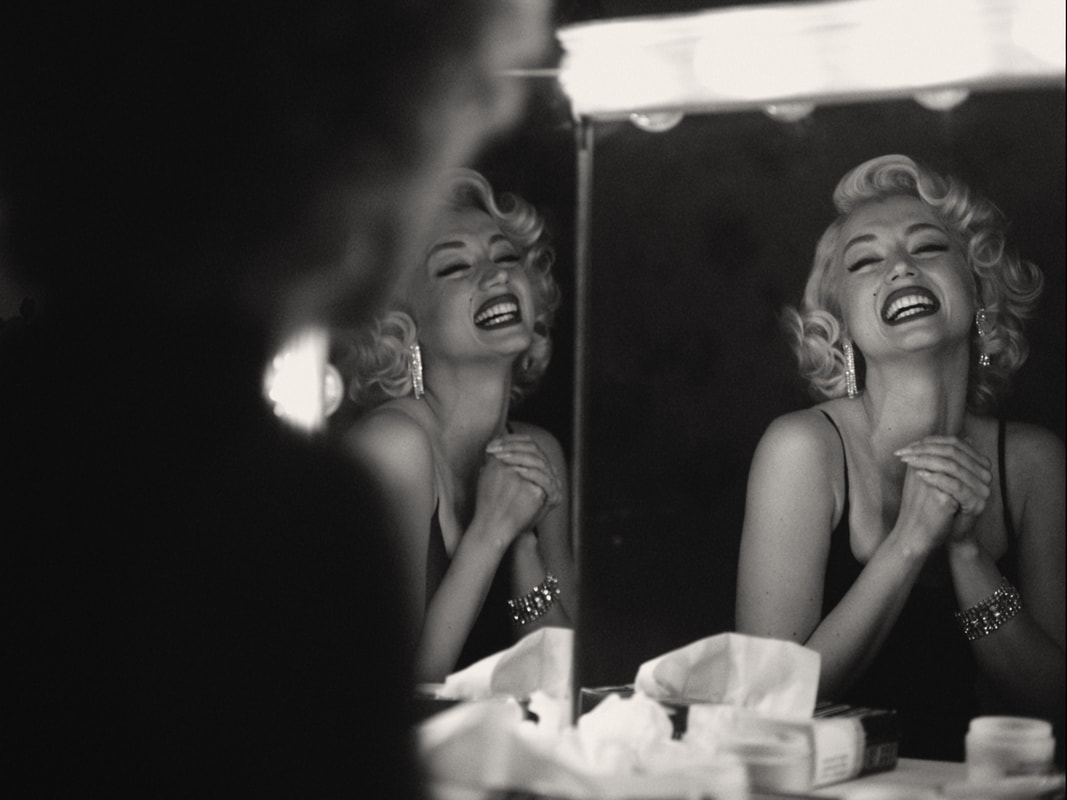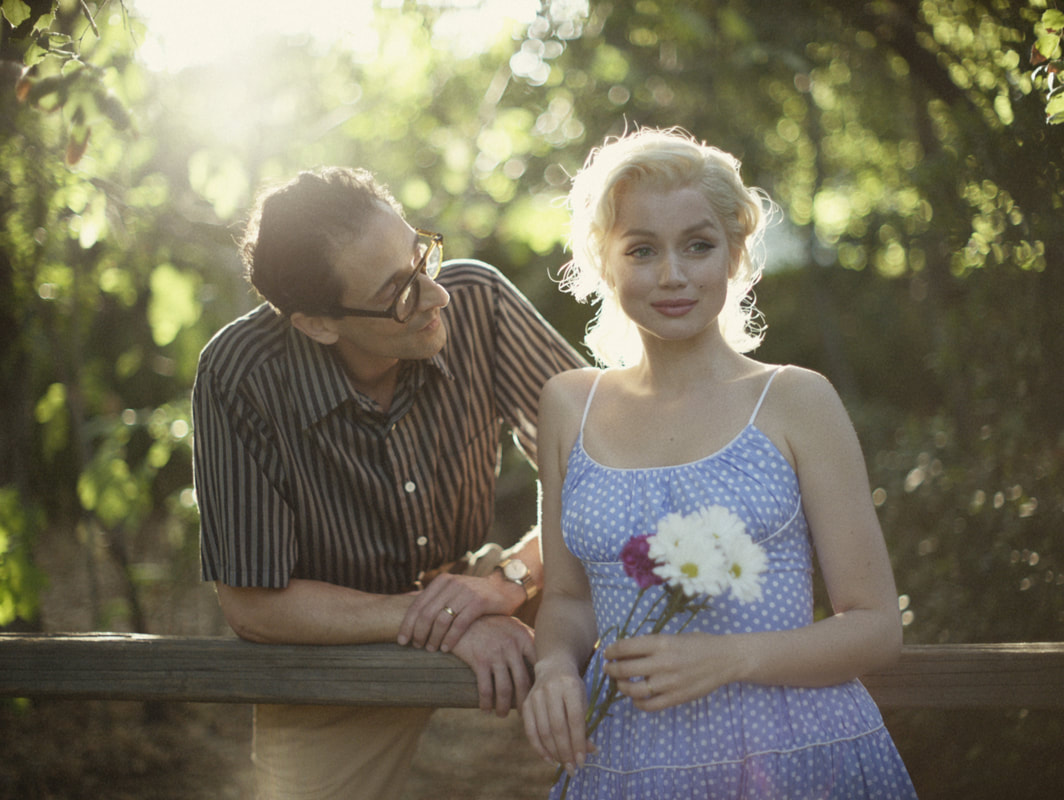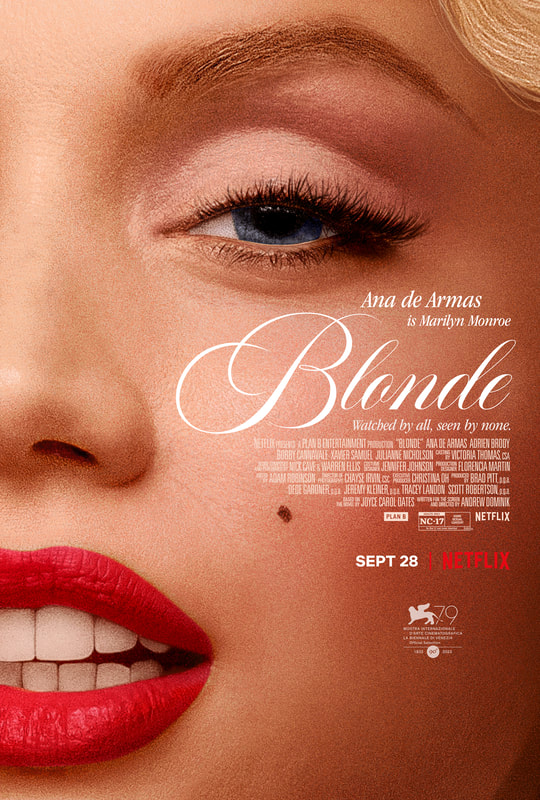|
Content / trigger warning: Blonde contains flashing and strobing effect imagery that may be triggering to those with photosensitivity. Blonde is rated NC-17 for some sexual content. It contains frightening and intense images involving abuse, assault, and abortion. These topics are briefly discussed in the review below. Blonde isn’t the feel-good biopic you’re looking for. Nor is it a sentimental tear-jerker. Andrew Dominik’s 2-hour and 46-minute adaptation of the Joyce Carol Oates novel is difficult, depressing, and demanding. It’s the kind of movie that made me tell my parents, “Don’t watch it, you won’t like it” (although the MPAA rating alone would have been enough to turn them away). But as I watched, I also felt that I, as a critic, wasn’t supposed to like it. With so many unconventional stylistic elements at play and so much controversial content, I felt like the only “correct” review I could give would be to call the movie problematic and pretentious. However, that review wouldn’t be genuine. There are certain shots, sequences, scenes, and techniques in Blonde that really don’t work — and yet, I found myself completely engaged with the film, not wanting it to end. It wasn’t until the JFK blowjob scene when a male critic in the audience burst out laughing (to my extreme annoyance, as I was sympathizing with Marilyn’s perspective and admiring what the scene had to say about sexual power dynamics) that I figured out what Blonde was doing right. It was making me aware of myself as a woman, as a critic, as a movie lover, and as a human. Blonde gave me one of the most powerful and visceral experiences I’ve had at the movies in a long time. For that reason, I don’t want to focus on all the little things that didn’t work. Instead, I want to focus on a few big things that it got right. After all, any movie that makes you more aware of yourself has to be doing something right. Blonde is a fictionalized account of the private life of Norma Jeane (Ana de Armas), the brunette model from LA who would become the iconic blonde bombshell known as Marilyn Monroe. If you aren’t familiar with the basic details of Marilyn’s life, Blonde will be difficult to follow. Dominik doesn’t spoon-feed us the info we need to follow the story (as directors often do with biopics), but instead attempts to tell Norma Jeane’s story through her own eyes by mimicking human perception and memory in both the cinematography and the script. Throughout the movie, Norma Jeane’s life flashes before us in a haze as if her memories have been extracted from her brain and put on film. The only issue is, we don’t have all the inside information that Norma Jeane had. Dominik puts those “memories” before us with very little context, throwing us right into the young actress’s world without so much as a “buckle up.” Plus, many of the details in the story have been fabricated for the sake of entertainment, making it even more difficult to follow. I’d recommend reading up on the life of Miss Monroe before watching Blonde, or at least having an internet-capable device handy to look things up while you watch at home. After a severely disturbing recap of Norma Jeane’s childhood, Blonde skips over her teen years and blazes forward through her early days as a model, her breakout into the movies, her early romantic affairs, her marriages, her successes, her failures, and most of all, her lifelong search for the approval and love of the father she never had. While there’s a heaping handful of internal and external conflicts at play for Norma Jeane, the story keeps circling back to her need for fatherly affection. This somewhat-central conflict lends structure to the highly unconventional plot, loosely tying the many themes together. And yet, there’s so much more to Blonde than that. Despite its emphasis on paternal approval, Blonde is undeniably feminine in its structure and style. The hazy montages, the warm and fuzzy images, de Armas’s soothing voice, and the lilting themes in the score create a comforting and womb-like cinematic experience. The bright, summery color palette (in the scenes of the movie that are not black and white) creates a dream-like feminine world reminiscent of The Virgin Suicides (1999). The narrow aspect ratio makes Norma Jeane’s memories look boxed-in, contained, and safe, enhancing the feeling of motherly comfort (granted, the aspect ratio changes throughout the movie, along with the color. There’s no clear rhyme or reason behind these changes, other than the mood of the scene at hand and the photographs that inspired it. While the random switches may be off-putting to some, they also make Blonde feel more dream-like). That isn’t to say that Blonde is all sunlit fields and flowers. You can’t make a biopic about a troubled star without some heavy scenes, and Dominik films the uncomfortable parts of Blonde in particularly disturbing and invasive ways. Perhaps it is because the movie has such a strongly established feminine perspective that the scenes involving assault, abuse, and mental illness seem so much more personal, invasive, and frightening. Dominik doesn’t give the audience the luxury of viewing those parts of Norma Jeanne’s life from a safe distance, but instead puts us (as best as one can with the tricks of cinematography) in her position. In an abortion scene, for example, Dominik includes a few shots in which the camera is positioned “inside” Norma Jeane, capturing the doctors and their medical instruments from an angle that makes them look much more terrifying than normal. In the aforementioned blowjob scene, Dominik forgoes the standard images of male pleasure and captures Norma Jeane at an awkward and unflattering angle that demonstrates (along with her voice-over narration) just how awkward that act can be when you’re emotionally manipulated and forced into it. The messages behind these intense scenes are sometimes questionable (the repeated image of a fetus in particular had me wrestling with potential pro-life messages in the movie), but Dominik is still successful in making those moments feel extremely personal. Blonde isn’t the kind of movie that allows you to sit down, get comfortable, and watch passively while the characters on screen tell you a story. It’s the kind of movie that’s meant to give you a physical, emotional, and psychological cinematic experience. It imitates memories and perception in order to create an experience that is altogether human. It is an impressionistic film in which Dominik takes classic images of Marilyn and flips them inside out, trying to get at the soul on the other side of the camera lens. The Marilyn in Blonde isn’t the Marilyn you know, and she’s not supposed to be.
0 Comments
Leave a Reply. |
"Our embodied spectator, possibly perverse in her fantasies and diverse in her experience, possesses agency...finally, she must now be held accountable for it." Categories
All
|






